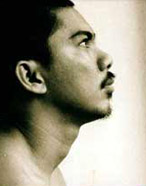 |
||
|---|---|---|
| CP Foundation | About CP Biennale | 2003 | 2005 | Contact Us | >||
           
|
||
|
This is the artwork by the artist Jumaldi Alfi which deals with the image of Gibran on two levels simultaneously: as functional object and as pure art. This placement of the image in two simultaneous conceptual positions indicates a playful exploration on the part of Alfi. Both positions can be given strongly defined borders, but can also, at the same time, cross those borders; almost without limitation. Initially, these 14 works were part of an order placed by a publisher to illustrate the cover of a book of Gibran's works. As part of his working agreement with the publisher making the order, Alfi had the authority to freely interpret the contents of texts of Gibran's works. The main result of this, as Alfi intended, was a most representative and 'ironic photographic image of Gibran. Alfi achieved this from the process of receiving the meaning of the text and connecting it with his creative ability. In almost each piece in this series, Gibran appears with a specific point of difference. With Gibran appearing as 'cover-boy', the visual forms are more or less capable of creating a point of identification which opens a window of understanding of the text created by Gibran for readers. So, should this series of 14 images of Gibran be presented in an entirely different space and time context, what would we read there? It seems that the result draws us into a kind of déjà vu phenomenon, in which one enters into a social and spiritual experience that feels familiar as if having been previously experienced. Observing the images of Gibran one by one seems like entering into a space and time warp in which different periods seem to merge as one, yet remain distinct. Another meaning which can be read from these works is apparent in the rather extreme title of this series of images. Within the terminology of pop culture, cover boy almost always brings to mind a funky and modern image of a young man being used to promote a specific product. Therefore, when a series of portraits of Gibran is grouped under the theme Cover-boy, Alfi's cynicism toward the unhampered spread of capitalism, with its unbridled use of idioms and icons to achieve its own expansion, becomes apparent. Kuss Indarto Born on July 19, 1973 in Lintau, West Sumatra. SELECTED SOLO EXHIBITIONS SELECTED GROUP EXHIBITIONS |
||
|
CP Foundation | About CP Biennale | 2003 | 2005 | Contact Us
Jl. Suryopranoto 67A, Jakarta 10160, Indonesia. ph. +62.21.3448126, 3853206 | fax. +62.21.3853203, 3853208 info@cp-foundation.org |
||
 Jumaldi Alfi is presenting 14 small canvasses grouped together under the theme Cover-boy. These canvasses are all exactly the same size. The main figure presented on the surface of each canvas is that of Khalil Gibran, the world-class author born in Beshari, Lebanon (1883-1931). He is depicted in a stereotypical pose, face forward, filling the entire surface of the canvas, visionary eyes, hair short, with a straying strand appearing as a visible line on the left side of his forehead, wearing specific Middle Eastern headgear and sporting a mustache. The only thing that differentiates one canvas from another is the variation of color combinations and the various different visual objects that are presented along with the portrait of the poet.
Jumaldi Alfi is presenting 14 small canvasses grouped together under the theme Cover-boy. These canvasses are all exactly the same size. The main figure presented on the surface of each canvas is that of Khalil Gibran, the world-class author born in Beshari, Lebanon (1883-1931). He is depicted in a stereotypical pose, face forward, filling the entire surface of the canvas, visionary eyes, hair short, with a straying strand appearing as a visible line on the left side of his forehead, wearing specific Middle Eastern headgear and sporting a mustache. The only thing that differentiates one canvas from another is the variation of color combinations and the various different visual objects that are presented along with the portrait of the poet.